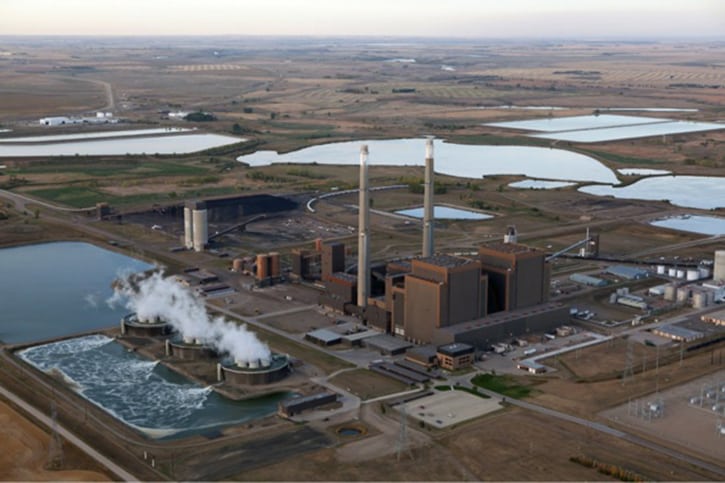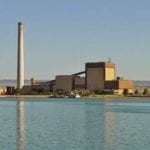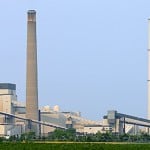The largest coal-fired power plant in North Dakota is
scheduled to close in 2022, with the Minnesota-based wholesale electric power
cooperative that operates the facility saying the lost generation will be mostly
replaced by wind power.
Minnesota-based Great River Energy, which supplies electricity to the suburbs of Minneapolis and St. Paul, along with other parts of the state, on May 7 announced it will close the 40-year-old Coal Creek Station power plant near Underwood, North Dakota. The plant, which employs about 260 workers, produces about half of the electricity that Great River sells to 28 member-owned electric cooperatives in Wisconsin and Minnesota, according to Jon Brekke, Great River’s vice president. Brekke said the move enables the utility to move “in an opportunistic direction towards an evolved power supply portfolio,” and reflects “significant shifts in the wholesale [power] market.”
The power cooperative said it plans to invest more than $1.2 billion to purchase more than 1,100 MW of wind power from new projects, including at least 600 MW of wind power in southern and western Minnesota. Great River also will review proposals for an additional 500 MW of renewable energy in Minnesota, South Dakota, and Iowa. The co-op also is investing in a large battery storage project in Cambridge, Minnesota.

“We are building a power supply portfolio that will serve our member-owner cooperatives for decades,” said David Saggau, Great River Energy’s president and CEO, in a statement. “We are taking advantage of cost-competitive renewables and reliable access to market energy while fostering innovation as the technology of our industry evolves.”
North Dakota Gov. Doug Burgum in a statement said, “While this news is disappointing, Lt. Gov. Sanford and I are more determined than ever to find a path forward for Coal Creek Station that preserves high-paying jobs and keeps North Dakota’s most efficient and updated coal-fired plant on the grid to ensure baseload power capacity for our state and the region. We remain committed to bringing stakeholders to the table to evaluate all options and find opportunity in this uncertainty.”
The state’s congressional delegation on Thursday also said it would work to keep the plant open under new ownership. North Dakota Republican Sen. John Hoeven said he continues to work toward tax credits for carbon capture and underground carbon dioxide storage, in part to make enhanced oil and gas recovery more commercially viable in a state that relies on the oil and gas industry.
Great River in a news release said it plans “to transform its portfolio of power supply resources in the coming years, significantly reducing member-owner wholesale power costs. The electric cooperative plans to phase out remaining coal resources, add significant renewable energy and explore critical grid-scale battery technology.”
“Like all of Great River Energy’s decisions, these changes are made in the best interests of our member-owner cooperatives,” Saggau said. “Coal Creek Station is operated efficiently, safely and with pride by a dedicated and talented staff. We will make every effort to minimize impacts on our employees and the communities through this transition.”
Specific Plans
The utility in Thursday’s announcement outlined its specific
plans, including:
- Retiring the 1,151-MW Coal Creek Station in the
second half of 2022. - Adding 1,100 MW of wind energy purchases by the
end of 2023. - Modifying the 99-MW, coal- and natural gas-fired
Spiritwood Station near Jamestown, North
Dakota to burn solely natural gas. - Installing a 1-MW, long-duration battery
demonstration system. - Supporting the repowering of the Blue Flint
biorefinery near Underwood with natural gas.
Great River Energy has been transitioning away from coal-fired power in recent years. The utility exited a contract for half the output of a Wisconsin coal plant in 2015; retired the coal-fired Stanton Station power plant in North Dakota in 2017; closed the waste-to-energy Elk River Resource Recovery Project in 2019; and has increased its purchases of power from several wind energy projects.
“Our power supply plans deliver on our member-owners’ three highest priorities: affordability, reliability and environmental stewardship,” Saggau said. “Electric cooperatives have a bright future in Minnesota.”
Unit 1 at Coal Creek came online in 1979. Unit 2 began operating in 1980. The plant was featured in POWER in 2014 in an article about how a team of the plant’s employees ran a series of in-house tests to determine the effectiveness of using the plant’s wet flue gas desulfurization system as a compliance solution for the Mercury and Air Toxics Standards rule.
Aid for Workers, Region
Great River has earmarked $15 million to distribute over the next five years to ease the economic impact on the Coal Creek plant’s workers and the region. In addition to the jobs at the plant, the facility supports about 480 jobs at the adjacent Falkirk Mine, which produces lignite coal for Coal Creek. The mine is operated by North American Coal Corp.
“We believe Coal Creek Station is an efficient, economic and attractive generation and capacity asset, and the continued long-term operation of the facility is in the best interest of our employees, the local community, region and state,” said J.C. Butler, president and CEO of North American Coal and its parent company, NACCO, in a statement.
Said Brekke: “We’re mindful on the impacts on the employees in the surrounding communities and we’re doing what’s feasible to mitigate those impacts with the voluntary payments that we’re making.”
Saggau said the plant would operate “until the second half
of 2022, and after that point it is our intention to dismantle the plant and
brownfield the site.” The company said it remains open to transferring
ownership of the plant.
“We’re not talking about selling it for a material price …
all of our discussions have been basically giving the plant to somebody and to
date we’ve had no takers,” Saggau said in a media call.
Great River last year finished upgrading a transmission line
that runs more than 430 miles from the Coal Creek plant east to Minnesota. The
company called the project one of its “most significant capital investments over
the last several years.”
Saggau said that with the moves announced Thursday, “Great
River Energy’s power supply will be more than 95% carbon dioxide free, [and] our
wholesale electric rate will also be significantly lower. We are building a
power supply portfolio that will serve our member-owner cooperatives for
decades.”
The company said its renewable energy generation capacity is
projected to grow from about 660 MW this year to more than 1,760 MW by the end
of 2023.
Great River Energy is working with Massachusetts-based Form Energy, a battery storage technology developer, on what it calls a first-of-its-kind demonstration of Form’s long-duration storage technology. The battery project in Cambridge, Minnesota, will be a 1-MW, grid-connected storage system capable of delivering its rated power continuously for 150 hours, far longer than the four-hour usage period common among lithium-ion batteries. The project is scheduled for completion in 2023.
—Darrell Proctor is associate editor for POWER (@DarrellProctor1, @POWERmagazine).










